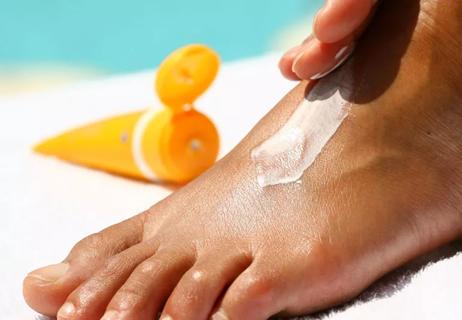Having darker skin tones doesn’t automatically offer protection from the sun

If you have a darker skin tone, you might think you’re protected from sun exposure and the likelihood of developing skin cancer, but that’s not true.
Advertisement
Cleveland Clinic is a non-profit academic medical center. Advertising on our site helps support our mission. We do not endorse non-Cleveland Clinic products or services. Policy
If you’re a person of color, skin cancer can present in different ways than people of lighter skin tones, and can often be overlooked and undiagnosed until late stages of development. By the time it’s discovered, according to the American Academy of Dermatology, it’s often more difficult to treat.
Dermatologist and skin of color specialist Kiyanna Williams, MD, explains why it’s important for people of color to protect their skin from the sun, along with some helpful tips for the sunnier months ahead.
There’s a common misconception that darker skin tones provide full protection from sun exposure — but that’s just as false as the idea that getting a base tan will protect you from a sunburn.
People of color should wear sunscreen every day to protect their skin from sunburn and more prevalent skin cancers that are on the rise, like basal cell carcinoma and squamous cell carcinoma.
But more than that, sunscreen has numerous other benefits that can help with conditions like hyperpigmentation, melasma and melasma mustaches — all conditions characterized by dark spots or patches on your skin that are worsened by sun exposure.
“If you have dark spots or even melasma, you can spend all your money on all of the various treatments, but if you’re not wearing sunscreen, those products won’t help. Every time the sun hits your skin, it makes those spots darker and stimulates more melanin production,” Dr. Williams explains.
Advertisement
“This includes when you’re directly in the sun and when you’re inside. Sunlight that comes through windows, light from your phone, light from your computer and indoor light can darken those spots as well.”
Melanin is responsible for your unique hair and eye color and it’s what differentiates your skin tone from someone else. It’s created in melanocytes, which are cells found in the inner layer of your skin. In these cells, carotene and melanin combine to create the colors of your eyes, skin and hair.
There are three types of melanin:
People of color tend to have higher quantities of melanin in their skin, which can offer some additional, minimal protection from ultraviolet (UV) rays. Melanin absorbs UV light before it can damage the DNA of your skin cells and it acts as an antioxidant by fighting free radicals and lessening the signs of aging like deep wrinkles and age spots.
But you shouldn’t rely on melanin to be your only skin protector: While this all sounds great, it doesn’t mean that people of color don’t have to worry about their skin — or that they don’t need to wear sunscreen.
According to the American Cancer Society, the estimated melanoma five-year survival rate for Black patients is 70% compared to 94% for white patients. Black patients are also more likely than white patients to present with late-stage melanomas.
There are a number of reasons for this that include numerous racial and ethnic healthcare disparities related to skin cancer in the U.S. Skin cancers also tend to present differently in Black, Hispanic and Asian individuals, with basal cell carcinomas appearing pigmented, squamous cell carcinomas having more association with scarring and inflammatory skin conditions, and melanomas being deeper and having spread across farther areas. Skin cancers also tend to show up in less common places like their nails, hands and feet.
“Basal cell carcinoma is often pink in color but can appear brown-blackish in those with darker skin,” clarifies Dr. Williams. “Melanoma can also present in places that are more ‘hidden’ such as the bottom of the feet or in between toes.”
Black and Hispanic participants in a 2018 study reported a belief that their skin cancer risk was low due to having darker skin tones and a lack of skin cancer in their family history. Those same participants recalled some discussion about wearing sunscreen as a preventive method for not further darkening their skin and to prevent aging, but noted that there was not an emphasis on reducing cancer risk or sunburn. Studies like this speak to the need for skin cancer awareness among Black populations and people of color.
Advertisement
“While skin cancer is less common in people of color, it still occurs,” notes Dr. Williams. “Since we know that it is often associated with worse outcomes, it makes it especially important that we be vigilant in protecting ourselves.”
Sunscreen reduces your risk for several types of skin cancers, but it also helps with a few other things. Some products that contain sunscreen also contain other ingredients that moisturize your skin all day long. Sunscreen also has anti-aging properties and helps reduce the likelihood of wrinkles.
Of course, not every product out there is perfect: Some ingredients in certain sunscreens can be harmful. But if you’re ever in doubt, check the label and talk to a healthcare provider or dermatologist about what they recommend for your skin.
Dr. Williams recommends people of color should use sunscreen with an SPF of 30 or higher for daily use. If you’re going to be outside for prolonged periods of time, go for one with a higher SPF (greater than 50).
Dr. Williams also highly recommends mineral sunscreens with zinc oxide and titanium dioxide in them. While they can leave a white cast, tinted options are less likely to do so. Tinted sunscreens also have iron oxides in them which will protect darker skin from indoor light, including light from electronic screens such as cellphones and computers. They’re also less likely to irritate your skin.
Advertisement
When you apply sunscreen, give it about five to 10 minutes to settle and blend in. But keep in mind that if you sweat a lot, you’ll need to reapply a mineral sunscreen often, usually once every two to three hours.
You should do a self-check every month for signs of skin cancer. If you notice something questionable about your skin or you’re experiencing some discoloration or hyperpigmentation in your skin, don’t hesitate to reach out to a dermatologist. They can do a more thorough full-body skin exam to relieve any fears or concerns you may have. And while it might seem like a lot of dermatologists aren’t familiar with the needs of skin of color, Dr. Williams says there are people like her in the specialty who can help.
“If there’s something you’re not sure about, something that’s been bothering you or something that you have questions about, make an appointment to see a dermatologist. Whether that be dark spots, a new growth that doesn’t look like other ones or questions about skincare products,” advises Dr. Williams. “We see people for a variety of reasons and we’re happy to help.”
And if past experiences with dermatologists have rubbed you the wrong way, Dr. Williams encourages you to be transparent with a new provider.
Advertisement
“As a patient, express any concerns you may have. It’s fine to say, ‘I had a bad experience with my last provider and I felt like they didn’t hear me or they didn’t understand me. I’m hoping that our experience can be better,’” encourages Dr. Williams.
“When you put it all out there, it lets your new provider know what they can do differently as they help you achieve your treatment goals.”
Learn more about our editorial process.
Advertisement

Polarized lenses have an added benefit of a special coating that reduces glare on reflective surfaces like water and snow

Even on cloudy days or simply running errands, sunscreen is a must

It’s easy to forget your ears, eyelids, lips and feet — but any exposed skin needs protection

More than just fashionable, the lenses reflect or block harmful UV rays and can reduce glare

Choose lotion-based options that contain titanium dioxide or zinc oxide

SPF makeup offers some protection, but you’re better off pairing it with sunscreen

Research shows that umbrella shade is less effective than sunscreen for preventing sunburn

An expert weighs in on sunscreen ingredients, application tips and more

Type 2 diabetes isn’t inevitable with these dietary changes

Applying a hot or cold compress can help with pain